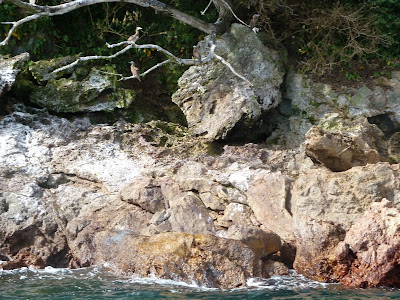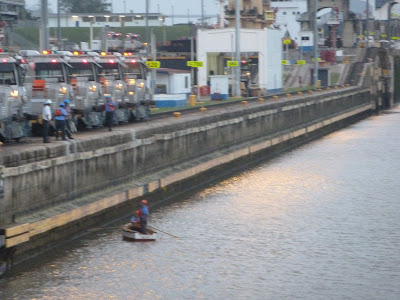We woke after cruising during the night to find ourselves anchored off the tiny Granito de Ora island in the Coiba National Park in Panama. The island is basically just a chunk of rock...
... jutting out of the Pacific Ocean, with a mop of dense vegetation atop and a few smaller rocks clustered around it...

On one side, a small stretch of sand provides a sheltered beach...

A cozy desert island, in other words, and an ideal spot for our morning of gentle relaxation. Here's the Sea Lion, from the shore:
The Zodiaks shuttled us with our snorkeling equipment from the Sea Lion to the beach, where the staff and crew had already been busy before breakfast, off-loading kayaks, underwater cameras and other gear for our enjoyment...

Since we were still relatively early in the day, Ellie and I decided to do our kayaking before the midday heat and, this time, requested the singletons. Barely launched from the beach, I somehow managed to lose my balance and overturn the little craft completely, ending up upside down in the shallows. Once aware of what was happening, I worried for a few moments about the possibility of being trapped in this position; but I actually just slipped out and came quite easily to the surface. Had I not, there were plenty of willing rescuers on hand. We had a good laugh about the incident—particularly when I heard that this was a first. Apparently no one before me had ever managed this feat.
(Sorry, no pictures!)
Once righted, I joined Ellie in a paddle around the entire island—not a huge achievement, since the island is so small, but a quiet pleasure in these blue waters, with a clear view, even at some depth, to the ocean floor.
Safely beached again, we donned our snorkeling gear. (How did we manage to miss this photo-op?) Like Ellie, I have had difficulty with this paraphernalia in the past; perhaps our equipment was of a cheaper, less reliable variety. This time, with the application of a little Vaseline around the mustache, I managed to get a good seal with the mask, which made everything a whole lot easier. (We had been advised, too, when the gear was initially distributed, to smear the inside of the mask with toothpaste and leave it to dry; once immersed and cleaned off, the toothpaste left a film on the inside of the mask effectively kept the lens clear of fog and condensation. A useful tip.)
The wild marine garden below the surface was magical. We swam around the rocks, above the coral beds, amongst fish of all shapes and sizes, some with lovely, bright, iridescent colors, who seemed as incurious about us as we were curious about them. Some spotted a shark lurking in the depths, but I was not so fortunate. I did, though, see a moray eel snaking in and out among the seaweed. We found ourselves in a beautiful, silent, constantly shifting alien world where we humans seemed the clumsy intruders—as odd, in a way, as if we were suddenly flying with the birds. Again, no underwater pictures, I fear: we did have a waterproof camera bag, but were too much concerned with other things to be willing to risk it. A little more familiar with how it should be done, however, we are encouraged to repeat this wonderful experience in the future.
I have always loved beachcombing...

... collecting shells, a hobby that’s now as inappropriate as collecting birds’ eggs—another of my youthful sins, as a boy in the English countryside. After our swim...

... and with the understanding that nothing could be removed, we combed the beach...

... and found some lovely shapes and colors....

Nothing very complete, to my astonishment. Mostly fragments. We made a collection of them...

... knowing that the tide would soon restore them to a more natural location. I suppose there must still be places in the world where perfect seashells are to be found. Here, those that remained intact, the small ones, were mostly occupied by the hundreds of hermit crabs scurrying everywhere along the shoreline.
Late morning, the Zodiaks arrived to take us back on board...

... where, after lunch, we enjoyed a slide lecture by Patty Hostiuck on butterflies and moths. Her talk was packed with fascinating, often surprising information; and once again, we were amazed at the complexity and refinement of the natural world, its innate intelligence, and the extraordinary perfection of its relationships.
After enjoying the luxury of a peaceful nap, we made our way to the ship’s prow, where we watched in more amazement as a quartet of dolphins sped through the water just inches ahead of us, rolling joyfully and leaping clear of the water to splash back down—as though to prove their agility so much superior to this human mode of marine transportation. A joy to watch. I’m afraid, again, that I did not manage to click my camera at the precise moment to catch the best of their leaps and rolls, but here they are...
Thursday, January 13
We had been warned. The Sea Lion’s captain took a moment a dinner time to announce that we would be traveling a good distance, all night, in fact, toward the Panama Canal; and that we would be passing, along the way, the Punta Mala—the “bad point,” where waters could be rough. And indeed, there were moments when the pitch and roll was quite dramatic. I do not suffer from motion sickness, but I did feel more than a little queasy at times during the night.
We were still sailing when we awoke, and came to anchor only at breakfast time, off the Otoque and Bona Islands in the Gulf of Panama. This is an area, our daily information sheet tells us, where “a break in the mountain chains that parallel the western coastline of several Central American countries allow the trade winds to blow over the Gulf, pushing surface waters away. Nutrient-rich waters from below upwell to replace these, bringing about an extremely high productivity that forms the basis of a complex web of life.” This last stop in the Pacific, then, was to allow us the opportunity to take a final Zodiak ride around one of the islands and enjoy the spectacle of some of the millions of seabirds who take advantage of this ecological wealth.
We joined the first of two expeditions, speeding across the gulf...

... to the remote island home of many of these birds...

The rocky coastline was an amazing sight...


The cliffs were crowded everywhere, mostly with Pelicans, Blue-Footed Boobies...


... and soaring Magnificent Frigatebirds—so named for the M marking on their plumage. We had arrived, it seemed, at the beginning of the nesting season, and already the white, fluffy hatchlings of the boobies were clearly visible...

... their parents perched close by in attendance. Again, our naturalist guides proved a well of information; and again, I have already forgotten much of what I learned. What stays with me are the majestic images, the moving experience of being with so many living creatures in their wild habitat. It is comforting to know that such places continue to exist in a world where human beings have so wantonly co-opted much of nature’s wealth.
Of which we were soon to be reminded, sailing on toward the Canal and finding ourselves a now tiny vessel amidst an international armada of massive cargo ships...

... all waiting at anchor for their turn to make the transit to the Caribbean. Beyond them, in the far distance, a view of Panama City with its (to us) surprising skyline of towering skyscrapers...

... many of them still under construction. Our own passage had been booked, so there was little waiting to be done. Approaching the entrance to the canal, we were boarded by the pilot...

... who would see us through the locks, and by a crew of blue-shirted line handlers...

... whose job it is to work with their counterparts onshore...

... to secure the towlines to the powerful locomotives...

... that move the traffic from their rails along the docks. A rowboat...

... ridiculously tiny and primitive beneath the hulking cargo ships, is used to assure the connection of lines thrown out between ship and shore; even an outboard motor, we were told, would risk tangling lines. All this was narrated, along the way, by Christian, a Panamanian, proud of his heritage, who had been one of our guides during the cruise.
Oh, here's Ellie, windswept, margarita in hand, as we approach the Bridge of the Americas:


... upward through the Miraflores and the Pedro Miguel locks and through the Culebra Cut to the man-made Lake Gatun, which separates the rising from the falling set of locks; and we all stood out on the decks, transfixed by the process—and by the engineering feat that made it possible. (We had watched, in the lounge with Christian, the David McCullough Nova episode on the amazing history of the canal, from its disastrous beginning in the hands of the French to its triumphant completion by American engineers—all at the cost of hundreds of human lives.) The canal is certainly one of the great engineering achievements of the human species. It is an awesome experience, to watch the “Panamax” ships—designed to just squeeze through the locks—being lifted by the rising water level between the massive concrete walls; but, all in all, I’d rather be in the rain forest.
Once through the locks, the Sea Lion set sail once again across Lake Gatun in the direction of the penultimate mooring place of our cruise... Still more to come.











3 comments:
Like a paradise...
I'm moving there tomorrow Peter and Ellie
I'm definitely impressed with your photography skills Peter!
As for the snorkelling, I'd not heard of the toothpaste trick; but when I was doing my training we were advised to spit in the mask.
Post a Comment